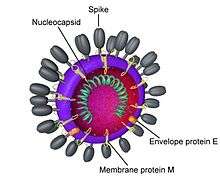Betacoronavirus
| Betacoronavirus | |
|---|---|
 | |
| Virus classification | |
| Group: | Group IV ((+)ssRNA) |
| Order: | Nidovirales |
| Family: | Coronaviridae |
| Subfamily: | Coronavirinae |
| Genus: | Betacoronavirus |
| Type species | |
| Murine coronavirus | |
| Species | |
|
China Rattus coronavirus HKU24 | |
Betacoronaviruses are one of four genera of coronaviruses of the subfamily Coronavirinae in the family Coronaviridae, of the order Nidovirales. They are enveloped, positive-sense, single-stranded RNA viruses of zoonotic origin. The coronavirus genera are each composed of varying viral lineages with the betacoronavirus genus containing four such lineages.
The Beta-CoVs of the greatest clinical importance concerning humans are OC43, and HKU1 of the A lineage, SARS-CoV of the B lineage, and MERS-CoV of the C lineage. MERS-CoV is the first betacoronavirus belonging to lineage C that is known to infect humans.[1][2]
The alpha- and beta-coronavirus genera descend from the bat gene pool.[3][4][5]
Virology

SARS-CoV virus causes SARS disease, and MERS-CoV virus causes Middle East respiratory syndrome (MERS) disease.
Sequence
Coronaviruses have a large genome size that ranges from 26 to 32 kilobases.
As of May 2013, GenBank has 46 published complete genomes of the α-(group 1), β-(group 2), γ-(group 3), and δ-(group 4) CoVs.[6]
Classification
Within the genus Betacoronavirus (Group 2 CoV), four lineages (a, b, c, and d) are commonly recognized.
- Lineage A includes HCoV-OC43 and HCoV-HKU1 (various species)
- Lineage B includes SARS-CoV (various species):
- Lineage C includes Tylonycteris bat coronavirus HKU4 (BtCoV-HKU4), Pipistrellus bat coronavirus HKU5 (BtCoV-HKU5), and MERS-CoV (various species)
- Lineage D includes Rousettus bat coronavirus HKU9 (BtCoV-HKU9)[7]
Morphology
The viruses of lineage A differ from all others in the genus in that they have a shorter spike-like protein called hemagglutinin esterase (HE).
The name Coronavirus is derived from the Latin “corona” meaning crown or halo, referring to their image under electron microscopy of crown-like spikes on their surface similar to the solar corona. This morphology is created by the viral spike (S) peplomers, which are proteins that populate the surface of the virus and determine host tropism. The order Nidovirales is named for the Latin nidus, which means nest. It refers to this order’s production of a 3' co-terminal nested set of subgenomic mRNA's during infection.[8]
See also
References
- ↑ ProMED. MERS-CoV–Eastern Mediterranean (06) (http://www.promedmail.org/)
- ↑ Memish, Z. A.; Zumla, A. I.; Al-Hakeem, R. F.; Al-Rabeeah, A. A.; Stephens, G. M. (2013). "Family Cluster of Middle East Respiratory Syndrome Coronavirus Infections". New England Journal of Medicine. 368 (26): 2487–94. doi:10.1056/NEJMoa1303729. PMID 23718156.
- ↑ Woo, P. C.; Wang, M.; Lau, S. K.; Xu, H.; Poon, R. W.; Guo, R.; Wong, B. H.; Gao, K.; Tsoi, H. W.; Huang, Y.; Li, K. S.; Lam, C. S.; Chan, K. H.; Zheng, B. J.; Yuen, K. Y. (2007). "Comparative analysis of twelve genomes of three novel group 2c and group 2d coronaviruses reveals unique group and subgroup features". Journal of Virology. 81 (4): 1574–85. doi:10.1128/JVI.02182-06. PMC 1797546. PMID 17121802.
- ↑ Lau, S. K.; Woo, P. C.; Yip, C. C.; Fan, R. Y.; Huang, Y.; Wang, M.; Guo, R.; Lam, C. S.; Tsang, A. K.; Lai, K. K.; Chan, K. H.; Che, X. Y.; Zheng, B. J.; Yuen, K. Y. (2012). "Isolation and characterization of a novel Betacoronavirus subgroup A coronavirus, rabbit coronavirus HKU14, from domestic rabbits". Journal of Virology. 86 (10): 5481–96. doi:10.1128/JVI.06927-11. PMC 3347282. PMID 22398294.
- ↑ Lau, S. K.; Poon, R. W.; Wong, B. H.; Wang, M.; Huang, Y.; Xu, H.; Guo, R.; Li, K. S.; Gao, K.; Chan, K. H.; Zheng, B. J.; Woo, P. C.; Yuen, K. Y. (2010). "Coexistence of different genotypes in the same bat and serological characterization of Rousettus bat coronavirus HKU9 belonging to a novel Betacoronavirus subgroup". Journal of Virology. 84 (21): 11385–94. doi:10.1128/JVI.01121-10. PMC 2953156. PMID 20702646.
- ↑ "Full-Genome Deep Sequencing and Phylogenetic Analysis of Novel Human Betacoronavirus - Vol. 19 No. 5 - May 2013 - CDC". Emerging Infectious Diseases. 2013-05-19. Retrieved 22 Apr 2014.
- ↑ "ECDC Rapid Risk Assessment - Severe respiratory disease associated with a novel coronavirus" (PDF). 19 Feb 2013. Retrieved 22 Apr 2014.
- ↑ Woo, P. C.; Huang, Y.; Lau, S. K.; Yuen, K. Y. (2010). "Coronavirus genomics and bioinformatics analysis". Viruses. 2 (8): 1804–20. doi:10.3390/v2081803. PMC 3185738. PMID 21994708.